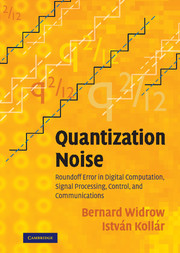 Quantization Noise
Quantization Noise Book contents
- Frontmatter
- Contents
- Preface
- Acknowledgments
- Glossary of Symbols
- Acronyms and Abbreviations
- Part I Background
- Part II Uniform Quantization
- Part III Floating–Point Quantization
- Part IV Quantization in Signal Processing, Feedback Control, and Computations
- Part V Applications of Quantization Noise Theory
- Part VI Quantization of System Parameters
- APPENDICES
- A Perfectly Bandlimited Characteristic Functions
- B General Expressions of the Moments of the Quantizer Output, and of the Errors of Sheppard's Corrections
- C Derivatives of the Sinc Function
- D Proofs of Quantizing Theorems III and IV
- E Limits of Applicability of the Theory — Caveat Reader
- F Some Properties of the Gaussian PDF and CF
- G Quantization of a Sinusoidal Input
- H Application of the Methods of Appendix G to Distributions other than Sinusoidal
- I A Few Properties of Selected Distributions
- J Digital Dither
- K Roundoff Noise in Scientific Computations
- L Simulating Arbitrary–Precision Fixed–Point and Floating–Point Roundoff in Matlab
- M The First Paper on Sampling–Related Quantization Theory
- Bibliography
- Index
E - Limits of Applicability of the Theory — Caveat Reader
from APPENDICES
Published online by Cambridge University Press: 06 July 2010
- Frontmatter
- Contents
- Preface
- Acknowledgments
- Glossary of Symbols
- Acronyms and Abbreviations
- Part I Background
- Part II Uniform Quantization
- Part III Floating–Point Quantization
- Part IV Quantization in Signal Processing, Feedback Control, and Computations
- Part V Applications of Quantization Noise Theory
- Part VI Quantization of System Parameters
- APPENDICES
- A Perfectly Bandlimited Characteristic Functions
- B General Expressions of the Moments of the Quantizer Output, and of the Errors of Sheppard's Corrections
- C Derivatives of the Sinc Function
- D Proofs of Quantizing Theorems III and IV
- E Limits of Applicability of the Theory — Caveat Reader
- F Some Properties of the Gaussian PDF and CF
- G Quantization of a Sinusoidal Input
- H Application of the Methods of Appendix G to Distributions other than Sinusoidal
- I A Few Properties of Selected Distributions
- J Digital Dither
- K Roundoff Noise in Scientific Computations
- L Simulating Arbitrary–Precision Fixed–Point and Floating–Point Roundoff in Matlab
- M The First Paper on Sampling–Related Quantization Theory
- Bibliography
- Index
Summary
The theory described in this book is very general: it describes well most quantization and roundoff situations. However, assumptions have been made which are necessary for proper application. In this appendix, some of these will be briefly described.
LONG–TIME VS. SHORT–TIME PROPERTIES OF QUANTIZATION
Statistical theory of quantization deals with statistics of signals: PDFs, CFs and moments. The basic idea is coined at the beginning of Chapter 4: “Instead of devoting attention to the signal being quantized, let its probability density function be considered.”
Having extensively explored the theory, a few basic questions need to be discussed, like:
when may the PDF be used?
what are the consequences of the use of the PDF in the application of the theory?
what has to be done if the PDF may not used, e.g. when the signal is deterministic?
For the introduction of the probability density function, Fig. 3.1(a) shows an ensemble of random time functions. These random time functions are realizations of a stochastic process. In practice, usually just one realization is measured, thus averaging is performed as averaging in time — which means that time averages are assumed to be equal to ensemble averages. In this case, the process is called ergodic (see page 43).
Quantization theory deals with statistical properties of ergodic processes. Fulfillment of QT I ensures that the PDF of x can be determined from the PDF of x′.
Information
- Type
- Chapter
- Information
- Quantization NoiseRoundoff Error in Digital Computation, Signal Processing, Control, and Communications, pp. 621 - 632Publisher: Cambridge University PressPrint publication year: 2008